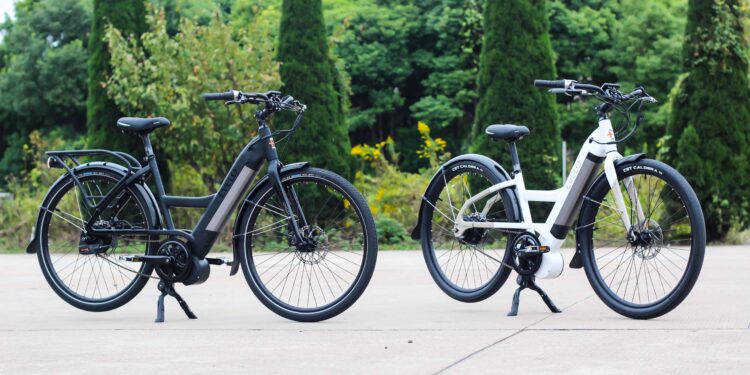Electric bikes, commonly known as e-bikes, have gained significant popularity as a means of transportation and leisure. They offer an efficient and eco-friendly alternative to traditional bicycles.
However, when exploring the world of e-bikes, you might come across different classifications such as class 1, class 2, and class 3. In this article, we will delve into the distinctions between these classes of e-bikes, examining their features, legal requirements, benefits, and drawbacks.
Introduction
E-bikes are bicycles equipped with an electric motor that assists the rider’s pedaling effort. The motor provides varying degrees of power, enabling riders to cover longer distances and conquer challenging terrains more easily.
Classifying e-bikes into different classes helps regulate their use, ensuring safety and consistency among riders.
Overview of Class 1 E-Bikes
Class 1 e-bikes are known as pedal-assist bikes. They are equipped with an electric motor that only provides assistance when the rider is pedaling.
The motor’s power is limited, usually not exceeding 750 watts. Class 1 e-bikes are designed to augment the rider’s pedaling effort, making it easier to climb hills or maintain higher speeds.
Legal requirements
In most regions, class 1 e-bikes are considered bicycles and are subject to the same rules and regulations. They can be ridden on bike lanes, paths, and roads where traditional bicycles are permitted. Class 1 e-bikes do not require a license or registration in most jurisdictions.
Benefits and drawbacks
The main advantage of class 1 e-bikes is their ability to extend the range and make pedaling less strenuous. They provide a smooth and natural riding experience, with the motor seamlessly matching the rider’s pedaling effort.
Class 1 e-bikes are ideal for recreational riders, commuters, and those seeking a reliable means of transportation without excessive speed.
However, some riders may find the limited power of class 1 e-bikes insufficient for more demanding rides or steep terrains. Additionally, the pedal-assist nature of class 1 e-bikes means that riders must maintain a consistent pedaling motion to receive assistance. This requirement may not suit riders who prefer a more relaxed or throttle-controlled experience.
Overview of Class 2 E-Bikes
Class 2 e-bikes, often referred to as throttle-assist bikes, are equipped with a throttle in addition to pedal-assist functionality. The throttle allows riders to activate the electric motor without the need for pedaling. This feature makes class 2 e-bikes more accessible to riders who may have physical limitations or simply prefer a hands-free experience.
Legal requirements
Class 2 e-bikes are subject to similar regulations as class 1 e-bikes in most jurisdictions. They are typically classified as bicycles, allowing them to be ridden on bike lanes, paths, and roads where traditional bicycles are permitted. Like class 1 e-bikes, class 2 e-bikes generally do not require a license or registration.
Benefits and drawbacks
The inclusion of a throttle in class 2 e-bikes provides riders with the convenience of on-demand motor power.
This feature is particularly useful for riders who may need an extra boost to overcome challenging terrain or want the option to ride without pedaling. Class 2 e-bikes are often favored by individuals looking for a more leisurely and effortless riding experience.
However, the reliance on throttle control means that class 2 e-bikes may not provide the same level of exercise or physical exertion as class 1 e-bikes. Additionally, the throttle feature can lead to higher energy consumption, resulting in a shorter battery life compared to class 1 e-bikes.
Overview of Class 3 E-Bikes
Class 3 e-bikes, also known as speed pedelecs, are designed for riders seeking a faster and more performance-oriented experience. These e-bikes offer higher maximum speeds compared to class 1 and class 2 e-bikes, typically reaching up to 28 miles per hour (45 kilometers per hour).
Legal requirements
Due to their higher speeds, class 3 e-bikes are subject to additional regulations in many jurisdictions. Riders may be required to wear helmets, and these e-bikes may need to meet specific safety standards. Class 3 e-bikes may also be restricted from certain areas or trails where lower-speed e-bikes are permitted.
Benefits and drawbacks
Class 3 e-bikes provide a thrilling riding experience, allowing riders to cover longer distances in less time. The increased speed is particularly advantageous for commuters who want to reach their destinations quickly.
However, the higher speeds of class 3 e-bikes necessitate enhanced control and attentiveness from the rider.
Riders must also ensure they adhere to local regulations regarding speed limits and safety requirements.
Comparison of Class 1, Class 2, and Class 3 E-Bikes
When considering the differences between class 1, class 2, and class 3 e-bikes, several factors come into play. Let’s examine these factors to help you make an informed decision:
Speed and power limitations
Class 1 e-bikes typically have a maximum assisted speed of 20 miles per hour (32 kilometers per hour), while class 2 e-bikes often have a similar limit. Class 3 e-bikes, on the other hand, can reach speeds up to 28 miles per hour (45 kilometers per hour).
Regarding power, class 1 and class 2 e-bikes usually have a motor power limit of 750 watts. Class 3 e-bikes may have higher power outputs, enabling them to achieve faster speeds.
Throttle assistance
Class 1 e-bikes rely solely on pedal-assist, requiring the rider to pedal in order to activate the electric motor. Class 2 e-bikes, in addition to pedal-assist, have a throttle that allows riders to activate the motor without pedaling. Class 3 e-bikes typically feature pedal-assist, but may also have a throttle for additional assistance.
Pedal-assist levels
All three classes of e-bikes provide pedal-assist functionality, but the level of assistance may vary. Riders can often choose from different levels of assistance, such as low, medium, and high, to suit their preferences and riding conditions. Class 3 e-bikes may offer more powerful pedal-assist modes compared to class 1 and class 2 e-bikes.
Use cases and terrain suitability
Class 1 and class 2 e-bikes are well-suited for a variety of riding scenarios, including recreational rides, commuting, and urban cycling. They offer a balance between assistance and physical exertion, making them suitable for riders of different fitness levels.
Class 3 e-bikes, with their higher speeds, are ideal for riders who prioritize speed and performance. They are often preferred by commuters who need to cover longer distances or individuals who enjoy fast-paced riding on open roads. However, class 3 e-bikes may not be suitable for crowded urban areas or trails with lower speed limits.
Legal restrictions and regulations
The legal requirements for each class of e-bike vary depending on the jurisdiction. Class 1 and class 2 e-bikes are typically treated as bicycles, allowing them to be ridden in similar areas and under the same regulations. Class 3 e-bikes, due to their higher speeds, may be subject to additional regulations, such as helmet requirements and specific safety standards.
It’s crucial to familiarize yourself with the local laws and regulations regarding e-bikes to ensure compliance and a safe riding experience.
Battery and motor specifications
The battery and motor specifications can differ between e-bike classes. While class 1, class 2, and class 3 e-bikes generally have similar motor power limits, the battery capacity may vary. Class 3 e-bikes, which often require more power for higher speeds, may have larger battery capacities to accommodate the increased energy demands.
When choosing an e-bike, consider your desired range and the battery’s capacity to ensure it meets your needs.
Choosing the Right Class of E-Bike
The choice between class 1, class 2, and class 3 e-bikes ultimately depends on your riding preferences, intended use, and local regulations. Here are some considerations to help you make an informed decision:
Considerations for beginners and casual riders
If you’re new to e-bikes or prefer a more traditional biking experience, class 1 e-bikes are a great choice. They provide assistance while still requiring you to pedal, giving you the opportunity to enjoy the health benefits of cycling.
Considerations for commuting and urban riding
For commuting and urban riding, both class 1 and class 2 e-bikes can be suitable options. Class 1 e-bikes provide pedal-assist, ensuring you get exercise while commuting, while class 2 e-bikes offer the added convenience of a throttle for hands-free operation when needed.
Consider factors such as the distance of your commute, terrain, and local regulations to determine which class suits your needs best.
Considerations for off-road and mountain biking
If you’re an adventure seeker or enjoy off-road trails and mountain biking, class 1 or class 3 e-bikes may be more appropriate. Class 1 e-bikes provide pedal-assist for an enhanced riding experience, while class 3 e-bikes offer greater speed and performance for tackling challenging terrain.
However, ensure you are familiar with the regulations and restrictions in your area regarding e-bike usage on trails and off-road areas.
When choosing an e-bike, take into account your riding preferences, fitness level, intended use, and local regulations. Test ride different classes of e-bikes to get a feel for their capabilities and find the one that suits your needs and riding style best.
Conclusion
In conclusion, the difference between class 1, class 2, and class 3 e-bikes lies in their power, speed limitations, and assist modes.
Class 1 e-bikes provide pedal-assist, class 2 e-bikes offer both pedal-assist and throttle assistance, and class 3 e-bikes provide higher speeds for a more performance-oriented experience. Choosing the right class of e-bike depends on factors such as your riding preferences, intended use, and local regulations.
Remember to always adhere to local laws and regulations when riding any class of e-bike. Enjoy the benefits of e-biking while respecting the environment, fellow riders, and pedestrians.
FAQs
- Are e-bikes legal on all public roads? Yes, e-bikes are generally legal on public roads, but specific regulations may vary depending on your jurisdiction. Familiarize yourself with the local laws and restrictions regarding e-bike usage.
- Can I modify a class 1 e-bike to become a class 3 e-bike? It is not recommended to modify an e-bike to change its classification. Modifying an e-bike’s speed and power capabilities can lead to legal and safety issues. It’s best to choose an e-bike that aligns with your desired class from the beginning.
- What are the speed limits for each class of e-bike? Class 1 and class 2 e-bikes typically have a maximum assisted speed of 20 miles per hour (32 kilometers per hour), while class 3 e-bikes can reach speeds up to 28 miles per hour (45 kilometers per hour).
- Do e-bikes require a driver’s license? In most jurisdictions, e-bikes do not require a driver’s license. They are classified as bicycles as long as they meet the specific criteria for each class. However, it’s important to check the regulations in your area as they may vary.
- How long do the batteries of e-bikes last? The battery life of an e-bike can vary depending on factors such as usage, terrain, rider weight, and assist levels. On average, e-bike batteries can last anywhere from 20 to 60 miles (32 to 96 kilometers) before requiring a recharge. Battery technology is continuously improving, so newer e-bike models may offer longer battery life.












Ahаa, its pleasant conversation on the topic of this
article at this place аt this webpage, I һave read alⅼ that,
so at this time me also commenting here.
I’m glad you enjoyed the conversation and the article. It’s great that you’ve read everything and decided to leave a comment here. Thank you!